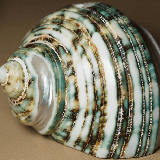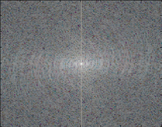Spatial frequency

The spatial frequency (also spatial frequency , symbol k or R ) is the reciprocal of the spatial period length .
physics
In general, the term period is associated with the idea of a change in size that is periodic over time . But the concept of period can easily be extended to any periodic functions , including spatially varying quantities.
If the considered physical quantity is dependent on the one-dimensional position, then the period length has the dimension of a length and is specified in meters (m) in the international system of units . Accordingly, the spatial frequency indicates the number of periods per unit of length, i.e. it has the dimension 1 / length. The wave number in periods per centimeter is used for the spatial frequency of electromagnetic waves and the unit line pairs per millimeter (Lp / mm) for frequency brooms (Fig.).
The characterization of a spatially variable function according to components with certain spatial frequencies is not as clear as the decomposition of a sound into fundamental and overtones , but it provides the basis for Fourier optics and image compression algorithms such as B. JPEG .
Perceptual Psychology
In the perceptual psychology of seeing, the spatial frequency is related to the angle of vision , unit “periods per degree”. Images in which low spatial frequencies dominate are blurred and flat, images with high spatial frequencies are rich in detail and with easily recognizable outlines. In the visual cortex there are neurons that specialize in certain spatial frequencies (and the orientation of the edges). The ratio of the perceived to the actual contrast of the object is specified as the Contrast Sensitivity Function (CSF). The CSF is a product of the purely optical modulation transfer function (MTF) from the object to the retina and the retinal transfer function (RTF) from the image on the retina to higher perceptual functions. The MTF drops steeply from ten periods per degree. The RTF is flat for rapidly changing stimuli, for static images it drops to low spatial frequencies, see afterimage .
Individual evidence
- ^ L. Maffei, A. Fiorentini: The visual cortex as a spatial frequency analyzer . Vision Research 13, 1973, doi: 10.1016 / 0042-6989 (73) 90201-0 .
- ↑ George Mather: Foundations of Perception . Psychology Press, 2006, ISBN 978-0863778346 , limited preview in Google Book Search.


